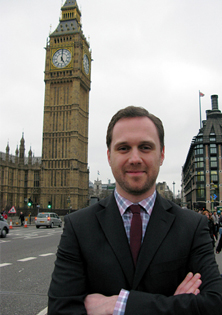Former Mellon College of Science Post-doc Presents Research to British Parliament
 An audience in front of legislators is often a privilege reserved for seasoned experts in a field of study. And in some cases it’s an honor for rising stars like Euan Wielewski.
An audience in front of legislators is often a privilege reserved for seasoned experts in a field of study. And in some cases it’s an honor for rising stars like Euan Wielewski.
A former Carnegie Mellon University post-doc, Wielewski, now a faculty member at the University of Glasgow, was one of 210 early career researchers invited to present to the British Parliament as part of SET for Britain, a poster competition in the House of Commons.
“This annual competition is an important date in the parliamentary calendar because it gives MPs (Members of Parliament) an opportunity to speak to a wide range of the country’s best young researchers,” said Andrew Miller, chairman of the Parliamentary and Scientific Committee. “These early career engineers, mathematicians and scientists are the architects of our future, and SET for Britain is politicians’ best opportunity to meet them and understand their work.”
Wielewski presented research that he conducted as a post-doctoral researcher at Carnegie Mellon and Cornell universities under the guidance of Carnegie Mellon Physics Professor Robert Suter. The research focuses on using near-field High Energy Diffraction Microscopy (HEDM), a technique developed by Suter, to determine the likelihood for failure of materials used to make parts for jet engines.
"Presenting our research at the Houses of Parliament was a real honor and a great experience. During the event I spoke with a number of different Members of Parliament and hopefully managed to communicate to them the importance of our work. If we want science and engineering research to continue to be supported then we need to convey our results to the public and their representatives. It's rare that early career researchers get the opportunity to talk to politicians about their work,” Wielewski said.
Most materials, including those used in many airplane parts, are polycrystalline, which means they are made of aggregates of crystals or “grains.” These grains can have differing shapes, sizes and orientations, and are joined together by a network of grain boundaries. During manufacturing and through the normal wear and tear of everyday use, materials can be exposed to a number of stressors including heating and cooling, and mechanical and chemical stress. When this happens, the grain boundaries move, causing the grains to change sizes and alter the boundaries between them. As a result, gaps can form between, or even within, the grains. These gaps can cause the materials to fail.
To study how grains respond to stress and high temperatures, researchers use high-energy x-ray technology to peer deep inside materials. Near-field HEDM maps grain shapes and orientations in three dimensions, allowing researchers to map and monitor how materials respond to stress and create simulations to see if and how a material will fail.
Wielewski’s project studied the complex microstructure of a titanium alloy that is used in many applications, including jet engines. The material undergoes a high-temperature phase transition during standard processing, which causes the grains to become convoluted. Wielewski mapped these grains in three dimensions at room temperature and then deduced what the material’s microstructure looked like during processing. Additionally, after measuring the grains, Wielewski increased the tension applied to the material and remeasured the grains. This capability to measure, treat, and re-measure a material multiple times is unique to HEDM, and this marked the first time it was applied to this important class of materials.
Although Wielewski is no longer at Carnegie Mellon, he plans to continue collaborating with Suter and extend this work to study variations in materials’ structure that result from subtle changes in processing conditions. Combining such measurements with direct observations of mechanical properties and large-scale computational modeling should lead to improved, more efficient processing methods and to the development of materials with improved properties.
###
By: Jocelyn Duffy, jhduffy@andrew.cmu.edu, 412-268-9982